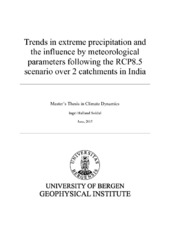Trends in extreme precipitation and the influence by meteorological parameters following the RCP8.5 scenario over 2 catchments in India
Master thesis
Permanent lenke
https://hdl.handle.net/1956/10304Utgivelsesdato
2015-06-02Metadata
Vis full innførselSamlinger
- Geophysical Institute [1198]
Sammendrag
The Historical1 simulation (1960-2000) and the RCP8.5 scenario (2060-2100) from the NorESM are used to investigate trends in extreme precipitation, as well as the impact from vertical velocity, specific humidity, divergence and temperature on the precipitation formation. The calculations are performed over the Indian catchments Godavari and Krishna, and are restricted to the monsoon season (June-September). Precipitation from the APHRODITE observations are used to validate the NorESM precipitation, and the vertical velocity, specific humidity, divergence and temperature are validated against the NCEP1 reanalysis. The calculated trends in extreme precipitation show that both the yearly mean intensity and the yearly number of events will increase in the future, by approximately 30 % and 40 % (90 % over Krishna), respectively. Using linear regression analysis, the vertical velocity is found to be the most important factor in the formation of extreme precipitation with a correlation of 0.66 over Godavari and 0.47 over Krishna. Along with the specific humidity, most of the precipitation amounts can be accounted for by only including these two parameters, while the temperature is assumed to be less important. A simple model is also applied to estimate precipitation under the assumption that an air parcel follows the moist adiabatic lapse rate. This estimated precipitation is underestimated, and the extreme precipitation has its maximum values 20 mm below the NorESM extreme values. This shows the importance of including diabatic terms such as radiative cooling, which increases the condensation rate of an air parcel.
